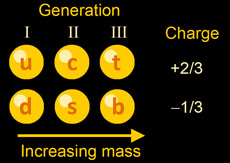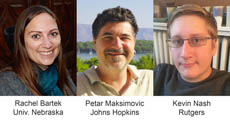Why three?
 |
| The Standard Model includes six types of quarks, arranged into three generations. Only generation I is necessary to make ordinary matter. So why are there three generations, and what message are the other four quarks telling us? |
There are a lot of mysteries in particle physics, but one of the most curious is called the flavor problem. Physicists use the word flavor to mean the different varieties of particles. As readers of this column will recall, there are six types of quarks: up and down, charm and strange, and top and bottom. Up and down quarks are found in ordinary matter and are called generation I. The other two generations are very similar in their properties compared to the first generation, but they have higher mass.
So why are there these two other copies? Scientists have many ideas. One is that the quarks contain smaller particles within them. While these smaller particles have never been found, they already have a name — preons. Another idea is that there may be only one generation, but this generation exists in a higher dimensional space. In the same way that a football viewed end on looks like a circle while looking like, well, a football from the side, perhaps the different generations are just a single particle seen from different angles.
Nobody knows the answer to the flavor problem, and, to share a personal note, this particular physics problem is the one that keeps me awake at night. The existence of these extra generations would tell us something profound about the universe if we just had the wits to understand what it is saying.
Another interesting possibility is that there are other generations, say generation IV. We already have names for the quarks of that generation — t' and b', pronounced "t prime" and "b prime." However, no evidence for the existence of this fourth generation has been found. Indeed, a measurement from experiments from back in the 1990s using the LEP accelerator at CERN suggests that there are only three generations. There are possible loopholes in that measurement, but it might well be that there are but three generations.
Yet another idea, generally based on the preon concept, is that the hypothetical constituents of the quarks can be given energy. Just as a slumbering beehive is different from one that was recently kicked, maybe enough energy can stir up the quarks' constituents.
In the simplest incarnation, this principle should be true of all quarks, but one could also imagine adding energy only to the constituents of the third-generation quarks. Scientists call such a configuration an excited quark and denote such a quark with an asterisk. So CMS scientists went looking for a b*. The idea is that the b* would be a very massive particle and could decay into a W boson and a top quark. No evidence was found for a b*, and physicists ruled out the existence of a b* with a mass below about 1,500 GeV. A particular peculiarity of this particle is that it wouldn't get its mass from the Higgs field, but from the energy that excited the quark.
A negative measurement isn't as much fun as a positive one, but at least we know what's not the answer for the flavor problem, and that's progress. But it doesn't help my insomnia, and so we keep looking, hoping to solve this thorniest of problems.
—Don Lincoln
 |
| These U.S. CMS scientists made important contributions to this analysis. |
|